![]()
![]()
![]()
Use LEFT and RIGHT arrow keys to navigate between flashcards;
Use UP and DOWN arrow keys to flip the card;
H to show hint;
A reads text to speech;
10 Cards in this Set
- Front
- Back
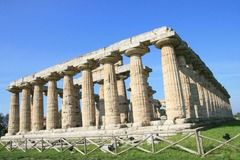
|
(Architecture) Basilica of Paestum 550BC Period/ Style: Doric temple design Architect: unknown Function: dedicated to Hera, now called the Temple of Hera I Context: the large building had an entablature, a frieze, a pediment, and any designs that followed the Doric style Descriptive Terms: Doric, columns, Greek, Grand, Hera Ideas relevant to the work of art: It is an Archaic temple, having many unusual features. Materials/Techniques: Stone, the central row of columns that divides the cella into 2 aisles. The columns are underneath the ridgepole as interior support. Patron: Greek Citizens |
|
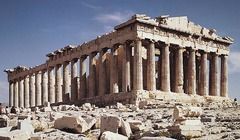
|
(Architecture) Parthenon 440BC Period/Style: Byzantine, Catholic, Ottoman, Athens Architect: Iktinos and Kallikrates Function: dedicated to Athena Context: The Parthenon was attacked and became converted into a Byzantine Church, then a Catholic Church in the Middle ages, and later into an Islamic mosque, after the Ottoman conquest. Descriptive Terms: Columns, Stone, Acropolis, Athena, Temple Ideas relative to the work of art: This structure is a mix of multiple unique cultures because every time it was converted to a new structure, it's design was modified. Materials/ Techniques: Stone, multi-cultures, Athena Patron: Acropolis citizens
|
|
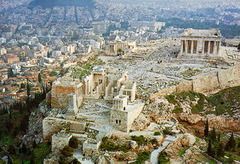
|
(Architecture) Aerial/ Restored View Acropolis Period/Style: The Parthenon, now, 20th century Architect: Iktinos and Kallikrates Function: dedicated to Athena Context: The current remains picture show the Parthenon, the Temple of Athena. The original protecting walls and entrance pathway, with stairs, are still visible. Descriptive Terms: Ruins, Remains, Modern Ideas relative to the work of art: This modern picture is a good comparison to the restored view of the original structure o the Acropolis, Athens, Greece. Material/Technique: Aerial View of the remains of Acropolis, Athens, Greece Patron: Used as study material |
|

|
(Architecture) Erecthion 420 BC Period/Style: Acropolis, Athens, Greece Architect: Unknown Function: Built to replace the old Archaic Athena temple that the Persians had razed, honored Athena and housed the ancient wooden image of the goddess that was the Panathenaic Festival procession's goal Context: assymetrical plan of the Ionic Erechtheion is unique for a Greek temple and the antithesis of the simple and harmoniously balanced pan of the Doric Parthenon across the way Descriptive Terms: Multiple, unique, replacement, Athena, Erechtheus Ideas relative to the work of art: Erechtheus was an early Athens king. whose reign the ancient wooden idol of Athena was said to have fallen from the heavens, and Kekrops, another king of Athens, served as judge of the contest between Athena and Poseidon Materials/ Technique: stone blocks Patron: Athena, Erechtheus, Kekrops, etc |
|
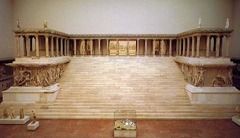
|
(Architecture) Altar of Zeus 175 BC Period/style: Reign of King Eumenes II Architect: Unknown Function: showed the battle between Zeus and the gods against the giants, one of the rare attempts of Greek artists to show conflict for control of the world Context: The platform was surrounded by frieze of almost four hundred feet long Descriptive Terms: Grand, Heaven, Gods, Zeus, Columns, Large stairway Ideas relevant to the work of art: most famous of all Hellenistic ensembles Materials/ Techniques: Marble, Stone,, elevated platform, Ionic stoalike colonnade Patron: Zeus, Gods, Giants |
|
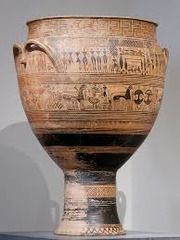
|
(Painting) Geometric Krater 740 BC Period/Style: Athenian Artist: Unknown Function: a huge crater, or mixing bowl, that marked the grave of an Athenian man buried around 740 BC Context: This vase is a considerable technical achievement and testifies both to the potter's skills and to the wealth and position of the deceased's family in the community Descriptive Terms: Krater, yellow, black , pattern, round Ideas Relevant to the work of art: Bottom of the vessel is open, perhaps to perm |
|
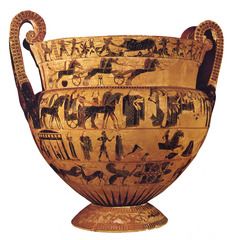
|
(Painting) Francois Vase Period/Style: Etruscan tomb, Ancient Greek Artist: Kleitias and Ergotimos Function: a burial item in an Etruscan tomb at Chiusi in Italy Context: It has more than two hundred in six registers. Labels around, naming humans and animals alike, even some inanimate objects. Descriptive Terms: signatures, human and animals drawings, mythology Ideas Relevant to the Work of Art: One of the earliest signs of having artists' signatures. Materials/Techniques: Clay, Only one of the bands was given over to the Orientalizing repertoire of animals and sphinxes. Patron: Owner of the tomb |
|
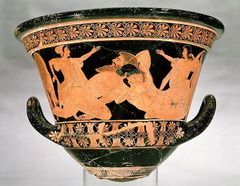
|
(Painting) Euphronios 510 BC Period/Style: Cerveteri, Italy Artist: Euphronios Function: possibly a type of decoration or a burial item Context: The krater depicts the struggle between Herakles and Antaios, revealing the exciting possibilities of the new red-figure technique Descriptive Terms: fighting, wrestling, Krater, Herakles, Antaios Ideas Relative to the Work of Art: Antaios, a Libyan giant, a son of Earth, derived his power through contact with the ground. Materials/Technique: Clay, thin glaze Patron: a middle class person
|
|
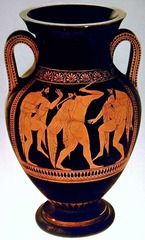
|
(Painting) Euthymides 510 BC Period/Style: Vulci, Italy Artist: Euthymides, a contemporary and competitor of Euphronius Function: a wine storage jar Context: Three tipsy revelers Descriptive Terms: Wine, Drunk, Storage, Euthymides, independent bodies Ideas Relevant to the Work of Art: the theme was also an excuse for the artist to experiment with the representation of unusual positions of the human form. The bodies do not overlap because they were a form of independent figure study. Materials/ Technique: Clay Patron: Middle Class people
|
|

|
(Painting) Battle of Issus 310 BC Period/Style: Roman Artist: Philoxenos of Eretria Function: decoration of the floor of one room of a lavishly appointed Roman house at Pompeii Context: The subject is a great battle between Alexander the Great and the Persian king Darius III, probably the battle of Issus in southeaster Turkey, when Darius fled the battlefield in his chariot in humiliating defeat. Descriptive Terms: Mosaic, panel painting, Roman, War Ideas Relevant to the Work of Art: The Philoxenos of Eretria was made for King Cassander, one of Alexander's successors. Materials/Techniques: Tesserae, tiny stones or pieces of glass cut to the desired size and shape Patron: King Cassander, Roman house at Pompeii |

